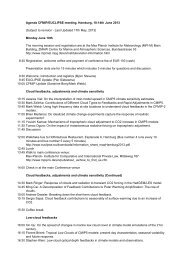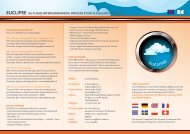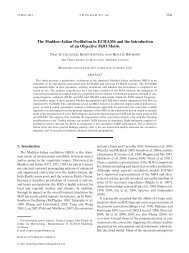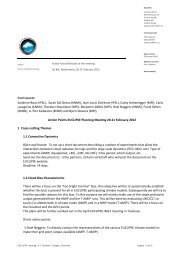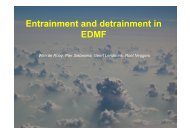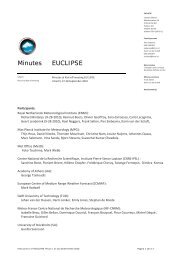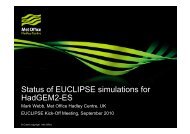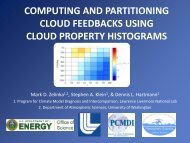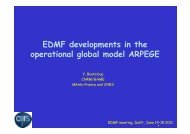EUCLIPSE First Period Report
EUCLIPSE First Period Report
EUCLIPSE First Period Report
You also want an ePaper? Increase the reach of your titles
YUMPU automatically turns print PDFs into web optimized ePapers that Google loves.
instantaneous COSP inputs have to be generated from the model, and then COSP is<br />
run independently.<br />
The latest version of COSP was implemented in the GCMs participating in <strong>EUCLIPSE</strong>,<br />
in fulfilment of Deliverable 1.3. These are the institutes that participated in this task:<br />
• UK Met Office (UKMO),<br />
• Laboratoire de Météorologie Dynamique/Institut Pierre Simon Laplace<br />
(LMD/IPSL),<br />
• Max-Planck Institut für Meteorologie (MPI-M),<br />
• Météo-France Centre National de Recherches Météorologiques (MF-CNRM),<br />
• Koninklijk Nederlands Meteorologisch Instituut (KNMI).<br />
These centres are running the following models as part of <strong>EUCLIPSE</strong>:<br />
• UKMO: HadGEM2<br />
• LMD/IPSL: LMDZ5<br />
• MPI-M: ECHAM6<br />
• MF-CNRM: CNRM-CM5<br />
• KNMI: EC-Earth<br />
COSP was implemented both off- and in-line at UKMO, in line at KNMI, and off-line in<br />
the other three modelling centers. The technical work of the implementation was<br />
aided significantly by the monthly teleconferences established by WP1, which enabled<br />
the group at UKMO (Bojas, Webb) to provide technical assistance to the rest of the<br />
modelling groups. A full report, entitled '<strong>Report</strong> on the implementation of ESM<br />
versions with COSP software, was posted on the <strong>EUCLIPSE</strong> web site<br />
(http://www.euclipse.eu/products.html) in April of 2011, fulfilling the requirement for<br />
Deliverable 1.3. The report shows examples of the COSP outputs for the different<br />
models, with figures showing outputs from the three instrument simulators (ISCCP,<br />
CALIPSO and CloudSat) from which outputs are requested for the <strong>EUCLIPSE</strong><br />
experiments. They show global and tropical (15° S-15° N) averages of the following<br />
variables:<br />
• ISCCP: histograms of cloud top pressure versus optical depth<br />
• CALIPSO: histograms of scattering ratio as a function of height<br />
• CloudSat: histograms of radar reflectivity as a function of height<br />
Here an example is shown of representative COSP output from a run of HadGEM2.<br />
Figure 2 shows COSP outputs from one July of an atmosphere-ocean coupled<br />
simulation of HadGEM2 with preindustrial forcings. The left-hand side column shows<br />
globally-averaged results, and the right-hand side column shows averages over the<br />
tropical belt (15° S-15° N): (a,b) ISCCP histograms, (c,d) CALIPSO histograms, and<br />
(e,f) CloudSat histograms.<br />
In addition to the more complex COSP package, a simpler simulator of MODIS<br />
products was constructed by MPI (Quaas). The simulator allows for a comparison of<br />
climate-model simulated cloud and aerosol fields with retrievals by MODIS and other<br />
space borne passive radiometers. The tool considers three steps: (i) the sampling of<br />
cloud-top quantities using the model's cloud overlap hypothesis, (ii) the satellite<br />
instrument sensitivity by discarding clouds with little cloud fraction or optical depth,<br />
and (iii) the diurnal sampling by taking into account the satellite overpass time for<br />
polar-orbiting satellites. The tool is easy to implement and easy to use, and has been<br />
tested widely.<br />
9



